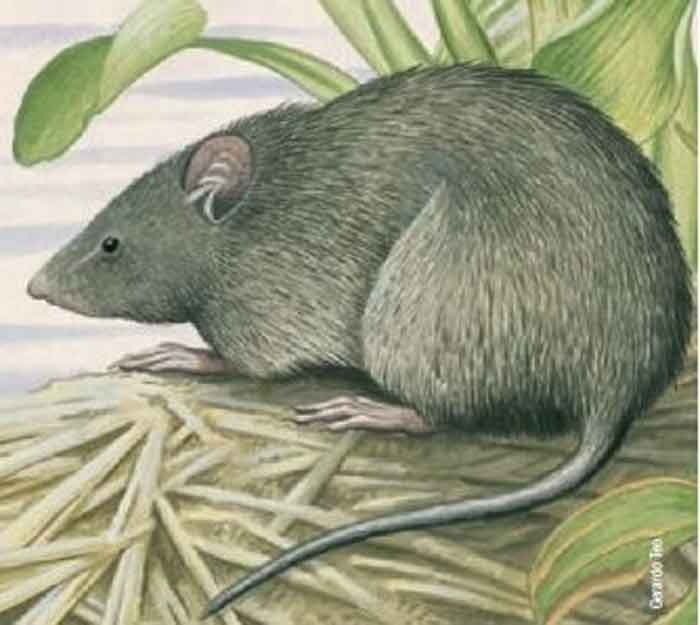
Superregnum: Eukaryota
Cladus: Unikonta
Cladus: Opisthokonta
Cladus: Holozoa
Regnum: Animalia
Subregnum: Eumetazoa
Cladus: Bilateria
Cladus: Nephrozoa
Superphylum: Deuterostomia
Phylum: Chordata
Subphylum: Vertebrata
Infraphylum: Gnathostomata
Megaclassis: Osteichthyes
Cladus: Sarcopterygii
Cladus: Rhipidistia
Cladus: Tetrapodomorpha
Cladus: Eotetrapodiformes
Cladus: Elpistostegalia
Superclassis: Tetrapoda
Cladus: Reptiliomorpha
Cladus: Amniota
Cladus: Synapsida
Cladus: Eupelycosauria
Cladus: Sphenacodontia
Cladus: Sphenacodontoidea
Cladus: Therapsida
Cladus: Theriodontia
Cladus: Cynodontia
Cladus: Eucynodontia
Cladus: Probainognathia
Cladus: Prozostrodontia
Cladus: Mammaliaformes
Classis: Mammalia
Subclassis: Trechnotheria
Infraclassis: Zatheria
Supercohors: Theria
Cohors: Eutheria
Infraclassis: Placentalia
Cladus: Boreoeutheria
Superordo: Euarchontoglires
Ordo: Rodentiaa
Subordo: Myomorpha
Superfamilia: Muroidea
Familia: Cricetidae
Subfamilia: Sigmodontinae
Tribus: Akodontini
Genus: Gyldenstolpia
Species: Gyldenstolpia fronto
Subspecies: G. f. chacoensis – †G. f. fronto
Name
Gyldenstolpia fronto (Winge, 1888)
Holotype: ZMUC s/n, anterior skull fragment (including right M1-M3 and left M1).
Type locality: “Lapa da Escrivania [= Lapa da Escrivânia] Nr. 5,” a cavechamber excavated by Peter W. Lund near Lagoa Santa, Minas Gerais, Brazil. The exact location of this cave is unknown, but was probably not far from the city of Lagoa Santa, 20 km N Belo Horizonte, Minas Gerais.
Combinations
Scapteromys fronto Winge, 1888: 44 [original combination]
Kunsia fronto: Hershkovitz, 1966: 116 [name combination]
Gyldenstolpia fronto: Pardiñas, D’Elía & Teta, 2009: 554 [name combination]
References
Primary references
Winge, H. 1888. Jordfunde og nulevende Gnavere (Rodentia) fra Lagoa Santa, Minas Geraes, Brasilien: med udsigt over gnavernes indbyrdes slaegtskab. E Museo Lundii Band 1(3). F. Dreyer: Kjöbenhavn. 178 pp. + 8 pls. BHL Reference page.
Hershkovitz, P. 1966. South American swamp and fossorial rats of the scapteromyine group (Cricetinae, Muridae), with comments on the glans penis in murid taxonomy. Zeitschrift für Säugetierkunde 31: 81–149.
Pardiñas, U.F.J., D’Elía, G. & Teta, P. 2009. Una introducción a los mayores sigmodontinos vivientes: revisión de Kunsia Hershkovitz, 1966 y descripción de un nuevo género Rodentia: Cricetidae). Arquivos do Museu Nacional, Rio de Janeiro 66: 509–594.
Links
Gyldenstolpia fronto in Mammal Species of the World.
Wilson, Don E. & Reeder, DeeAnn M. (Editors) 2005. Mammal Species of the World – A Taxonomic and Geographic Reference. Third edition. ISBN 0-8018-8221-4.
IUCN: Kunsia fronto (Endangered)
Vernacular names
English: Fossorial Giant Rat
português: Rato-do-mato
The fossorial giant rat (Gyldenstolpia fronto) is a species of rodent in the family Cricetidae.[2] It is found in Argentina and Brazil but was determined extinct following a recent assessment of the conservation status of Sigmodontine rodents.[3] Its natural habitat is assumed to be dry savanna, but there have been no ecological details reported.[4]
Taxonomy
Gyldenstolpia fronto is one of two species in the genus Gyldenstolpia. The other, smaller, species in the genus is G. planaltensis. In 2009, Gyldenstolpia fronto chacoensis and G. fronto fronto were acknowledge by Pardinãs, D'Elía, and Teta as two subspecies of G. fronto.[4]
It was previously considered part of the genus Kunsia but is now recognized in the genus Gyldenstolpia, a subset of Sigmodontine rodents known only from a few fossils and recent specimens found in central South America.[4] Gyldenstolpia fronto (G. fronto) and Gyldenstolpia planaltensis (G. planaltensis) are the only species comprising the genus Gyldenstolpia. They are relatively large in relation to other sigmodontines. Gyldenstolpia fronto is the larger of the two and displays a semi-fossorial body plan.
Morphology
Members of genus Gyldenstolpia are morphologically similar to Scapteromys and Kunsia. Defining characteristics of G. fronto include a robust skull with a restricted interorbital region; rounded, somewhat hidden ears; thick bristle-like dorsal hair, small eyes, and a short tail relative to overall body length.[4]
References
Pardinas, U.; D'Elia, G.; Teta, P.; Patterson, B. (2018). "Gyldenstolpia fronto". IUCN Red List of Threatened Species. 2018: e.T11062A22388720. doi:10.2305/IUCN.UK.2018-2.RLTS.T11062A22388720.en. Retrieved 15 November 2021.
Musser, G. G.; Carleton, M. D. (2005). "Superfamily Muroidea". In Wilson, D. E.; Reeder, D. M. (eds.). Mammal Species of the World: A Taxonomic and Geographic Reference (3rd ed.). Johns Hopkins University Press. p. 1122. ISBN 978-0-8018-8221-0. OCLC 62265494.
Formoso, Anahí; Teta, Pablo (2019). "Richness, Endemism and Conservation of Sigmodontine Rodents in Argentina". Mastozoología Neotropical. 26 (1): 99–116. doi:10.31687/saremMN.19.26.1.0.17. hdl:11336/128741.
Patton, James; Pardiñas, Ulyses; D'ELia, Guillermo (2015). Mammals of South America, Volume 2 Rodents. Chicago and London: The University of Chicago Press. pp. 222–225. ISBN 978-0-226-16957-6.
Retrieved from "http://en.wikipedia.org/"
All text is available under the terms of the GNU Free Documentation License

